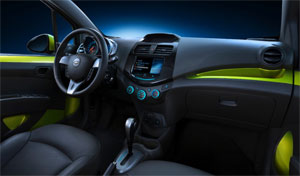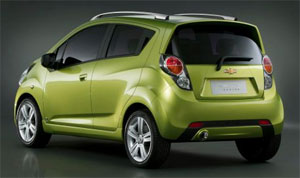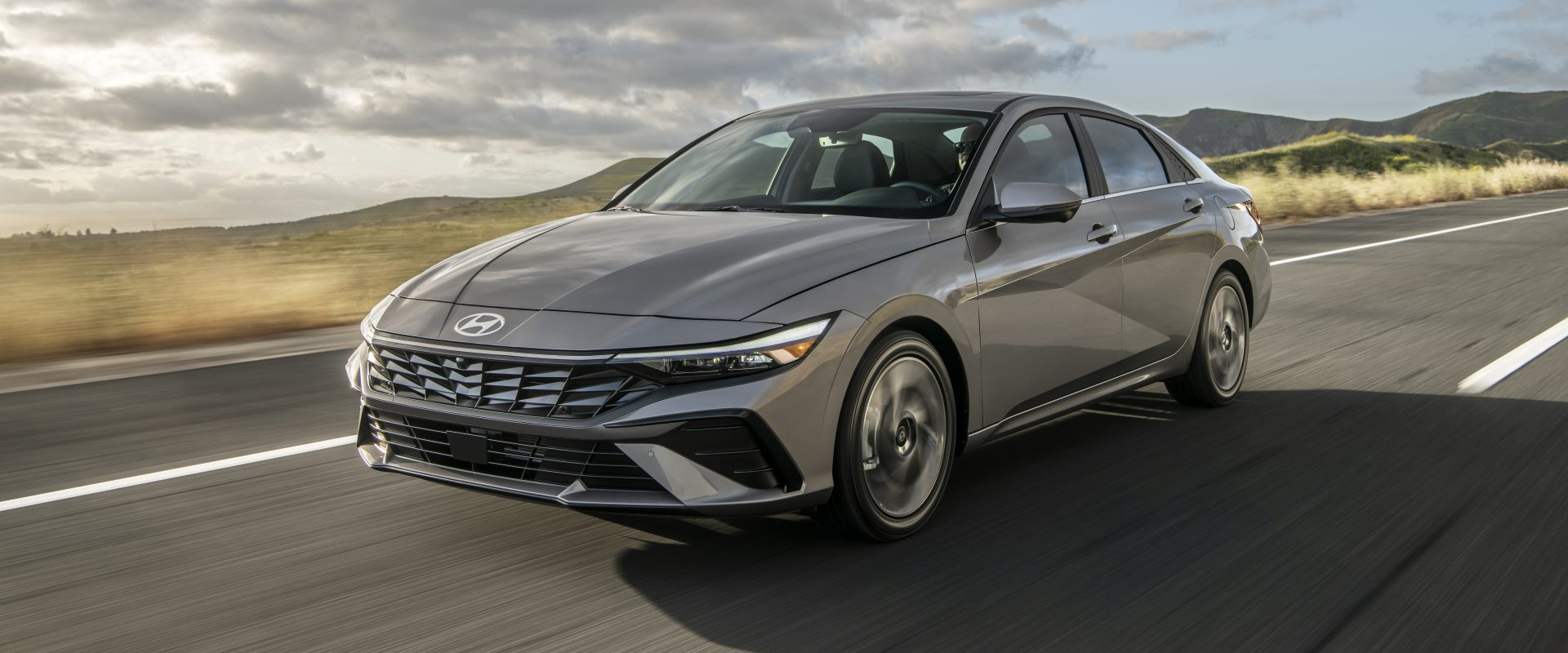2013 Chevrolet Spark
Mini cars, while still a niche market, they are proving their worth in a world of ever rising gas prices. And recent entries, like the Scion iQ and Fiat 500 are seeing some moderate success here in the states. Yet with no major domestic brand testing the waters, it’s hard to gauge their true potential. Well Chevrolet aims to change that with the all new Spark. So let’s see if it can spark the attention of American buyers.
The mini-car, those smaller than a subcompact, has never gained meaningful traction in America. Whether it’s a lack of power, aesthetic appeal, or versatility, buyers here expect style and substance for their hard-earned dollars. But, it only took a short time with the 2013 Chevrolet Spark, for us to conclude that there is plenty of both in this ultra-compact cruiser.
The hatchback Spark fits near the middle of its tiny, city-car class. With an overall length of 144.7 inches it’s about a half foot longer than the Fiat 500, yet dwarves the Scion iQ and Smart ForTwo. Covering so little ground makes it easy to park, although we thought its turning diameter would be smaller than 32.5 feet curb-to-curb.
Our top level Spark 2LT certainly scored style points with us. Its narrow, yet tall two-box shape is complete with trendy details like a chrome-trimmed low slung grille, and expressive headlights. Character lines sweep over standard 15 inch alloy wheels that are pushed to the corners. Rear door handles hidden in the C-pillars give the 5-door Spark the appearance of a sportier 3-door. The slightly-bulged tail end drops off quickly from our car’s hatch top spoiler. Big tail light clusters spill into the bumper, with a integrated chrome exhaust tip completing a look that adds more than a flicker of modern style to this city car.
 Inside that flare becomes a flame, as its trendy motorcycle inspired cockpit really shines with a host of “can-do’s”, including plenty of long distance room for two up front, and enough to squeeze two consenting adults in the back. Rear leg room is tight but bearable.
Inside that flare becomes a flame, as its trendy motorcycle inspired cockpit really shines with a host of “can-do’s”, including plenty of long distance room for two up front, and enough to squeeze two consenting adults in the back. Rear leg room is tight but bearable.
Under the hatch there’s more seat-up luggage room than any other mini car. And, once you figure out how to fold the split seats down correctly…it even took us a while…Spark accommodates 31.2 cubic feet of cargo, also the most in its class.
2LT seat upholstery is two-toned leatherette, and feels comfortable enough. Door and dash get the hard plastic treatment with body color accents. There’s a no-nonsense approach to climate, and heated seats are available. The stripped down gauge cluster augments an analog speedometer with a digital tach and trip computer screen.
We found Chevy’s MyLink touch screen audio system impressively easy to use. Standard on all but the base car, MyLink allows the use of popular apps like Pandora through your smartphone. With more apps coming, visual Navigation maps come courtesy of Bring-Go for a one time fee of only $50. All models include spoken navigation through OnStar.
Under the tiny hood sits a tiny Ecotec 1.2-liter I4. Rated at a meager 84 horsepower and 83 lb-ft of torque, the emphasis for Spark is efficiency. And indeed, Government Fuel Economy ratings place our five speed manual Spark at 32 city and 38 highway, for a combined 34 mpg. The front drive four-speed automatic has a combined of 32. We actually beat the ratings at 39.8 mpg. An Energy Impact Score of 9.7 barrels of annual oil consumption is on par with mini-car rivals. As are annual CO2 emissions of a low 4.3 tons.
Not surprisingly, the Spark didn’t exactly light up our test track, and clocked a zero to sixty time of 11.3 seconds. The quarter mile came in at an “are we there yet?” 18.2 seconds, at 80 miles per hour. And that’s with the five speed manual.
 Any shortcomings are easily forgiven with a base price of just $12,995. Even with all the niceties, like MyLink, sport trim, and heated seats, our 2LT Spark rang up to only $15,795.
Any shortcomings are easily forgiven with a base price of just $12,995. Even with all the niceties, like MyLink, sport trim, and heated seats, our 2LT Spark rang up to only $15,795.
So is the Spark going to set the car world ablaze? Well it’s hard to say… But at the very least, it shows a domestic brand is finally getting serious about very small cars. And we hope that’s one fire that doesn’t get snuffed out anytime soon.
Specifications
- Engine: Ecotec 1.2-liter I4
- Horsepower: 84
- Torque: 83 lb-ft.
- 0-60 mph: 11.3 seconds
- 1/4 mile: 18.2 seconds,@ 80 mph
- EPA: 32 mpg city/38 mpg highway
- Energy Impact: 9.7 barrels of oil/yr
- CO2 Emissions: 4.3 tons/yr
2024 Hyundai Elantra
Basic Transportation At Its Best…And That Is A Compliment
For those of you who write in every week bemoaning the fact that all we seem to do around here is test incredibly expensive cars and EVs that only the very well to do can afford, this one’s for you. It’s a commuter and budget friendly mainstay from Hyundai, the compact Elantra sedan. And, it has been nicely updated for 2024.
We clearly do enjoy driving high-performance machines and ultra-luxury rides around here, but like most of you, when it comes time to drive home at the end of a long workday, we do so in something much more practical and affordable, like this 2024 Hyundai Elantra sedan.
If you’re thinking the front end has gotten more aggressive, you’re right. Hyundai calls it a “Shark Nose” theme, and we’re guessing they were thinking more Great White than Hammerhead, though Megamouth shark would also apply. It helps for a low and wide look; more substantial than the typical compact. Other additions for ’24 include slimmer daytime running lights, revised stainless steel Hyundai emblem, reshaped front fenders, sport sedan-style rear diffuser with silver trim; a parametric pattern added to the C-Pillar, and new LED taillights that take up a lot more space on the highly sculpted decklid. Plus, new wheel designs in sizes ranging from 15- to 18-inches.
Standard engine in SE, SEL, and Limited grades is this naturally aspirated 2.0-liter I4 with 147 horsepower and 132 lb-ft of torque. Even with no hybrid assistance, it gets substantial Government Fuel Economy Ratings of 31 City, 40 Highway, and 34 Combined; we averaged a great 38.6 mpg of Regular.
Those high fuel economy numbers mean acceleration times are pretty high as well. It was in no particular hurry to get off the line at our test track, as after a slight jolt of power, it felt pretty sluggish going down the track, taking us a lengthy 9.4 seconds to hit 60 mph. Hyundai’s Intelligent Variable Transmission has some realistic simulated gear shifts built in, and they not only provided the feel of a true automatic, but kept engine noise from becoming overbearing. And while this 2.0-liter may not be a house-on-fire off the line, it has no problem keeping up with traffic, and feels like just the perfect amount of power for a practical and safe commuter car.
There are other engine options too. Two choices if you want to go faster, a 1.6-liter turbo with 201 horsepower in the Elantra N Line, and a 276-horsepower turbocharged 2.0-liter for the Elantra N; plus, one with even better fuel economy, a 1.6-liter hybrid with a 139 horsepower total output.
And despite some significant understeer, there was good feel through the cones of our handling course, both in steering and chassis feedback. We wouldn’t quite call it “point and shoot,” but it responded to inputs fairly quickly, with only moderate body roll. All-in-all, when it comes to performance, it doesn’t claim to bring a whole lot to the table, but does clearly overachieve with what it does bring.
And Hyundai is always overachieving when it comes to packing in features, yet has found a way of keeping things refreshingly simple with a good mix of touchscreen and manual controls. Lots of space too, both up front in the surprisingly wide front buckets, and in the rear bench with ample room for three. Updates for all Elantra interiors include softer materials on the door panels, upgraded instrumentation and additional charging ports, plus a surround view monitor and new H-Tex simulated leather for Limited trim.
Elantra pricing starts with an SE at $22,775, the SEL comes in at $24,725, Limited begins at $28,215, and the sporty N Line starts at $29,615. If you’re interested in the hybrid, base Blue starts at $27,400 with Limited at $30,600.
Some might say there’s not a whole lot that’s earth shaking about the 2024 Hyundai Elantra, but that’s mostly why we like it so much. When it comes to just delivering good, basic transportation with a high dose of unexpected amenities, Hyundai delivers once again.
Specifications
- Engine: 2.0-liter I4
- Horsepower: 147
- 0-60 mph: 9.4 seconds
- 60-0 Braking: 111 ft (avg)
- MW Fuel Economy: 38.6 MPG (Regular)
- Transmission: IVT
- Torque: 132 lb-ft
- 1/4 Mile: N/A (Track Maintenance)
- EPA: 31 City / 40 Highway / 34 Combined







